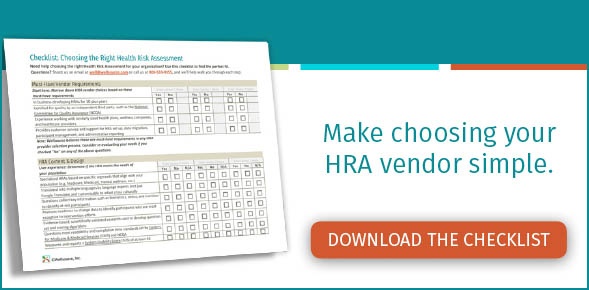Let’s face it. There are dozens of health risk assessment (HRA) vendors out there. Honing in on the perfect fit for your population can be a daunting task. In our forty-plus years in the HRA business, we’ve learned the important questions clients should ask to make their search easier. As great as our HRAs are, they’re not the perfect fit for every organization. These are the kinds of things that we find are important to the people who use our HRAs.
Quality
Not everyone cares about offering a health risk assessment that has passed the rigorous guidelines outlined by the National Committee for Quality Assurance (NCQA). Health plans and other organizations pursuing their own NCQA accreditation enjoy the benefits of using an HRA that has already been vetted by that organization. But even if your organization isn’t seeking NCQA Accreditation there are good reasons for using an NCQA-certified HRA. It assures you that the assessment is thorough, easy to understand, and scientifically solid.
Scientific validity
We value scientific evidence. That’s why our risk assessment algorithms and health enhancement recommendations are derived from guidelines and research published in peer-reviewed medical journals, and from leading health organizations, universities, and thought leaders. Our HRAs have been used in a significant body of scientific research, dissertations, and publications, making our HRAs some of the most established and valid questionnaires for assessing wellness today.
Easy integration
Because all of our HRAs are web-based Software-as-a-Service (SaaS) applications, our customers can choose the level of integration that they need. Our HRAs can be used as a stand-alone platform, partially integrated into a company’s portal, or fully integrated into a database. Customers who take advantage of our advanced integration capabilities appreciate our clear and complete documentation and supportive staff.
Positive user experience
Our HRAs are not only easy to read and understand, they’re also easy to take. Our most recent completion rate analysis showed that 91% of the people who start one of our assessments finishes it, and they do so in less than 13 minutes.
We conduct annual usability testing of our HRAs. This allows us to measure our product usability against our own goals as well as industry standards. The System Usability Scale (SUS), an industry standard for measuring usability, provides a subjective assessment against which we can measure our HRAs. A SUS score above a 68 is considered above average. Our score is 87—well above our goal of 70 or above. Users consistently give our HRAs high marks for ease of use and satisfaction with their experience.
The personal report reflects the individual’s responses to the HRA questions, and also captures year-over-year trends. The use of color, design, and graphic elements help make the report easy to read and understand.
Data
We approach health and wellness from the perspective of optimal health. We look at health behaviors that increase disease risk and ask about change readiness to help our clients craft interventions that will improve health trends in their populations. Our clients can access their data anytime, from anywhere, for free. We have configured a number of reports to make the job of data analysis easier—from aggregate reports to comprehensive spreadsheets. Some clients choose to pull HRA data directly into their own database using application programming interface (API) integration.
Privacy
Our state-of-the-art encryption keeps participant data private and secure. In accordance with government standards, all our staff complete regular privacy training.
There’s a lot to consider when looking for an HRA vendor. We’ve created a checklist to help you narrow down your search. Download our Checklist: Choosing the Right Health Risk Assessment below to see what other things you should consider to choose the right HRA.








